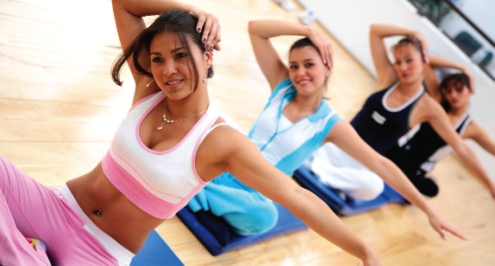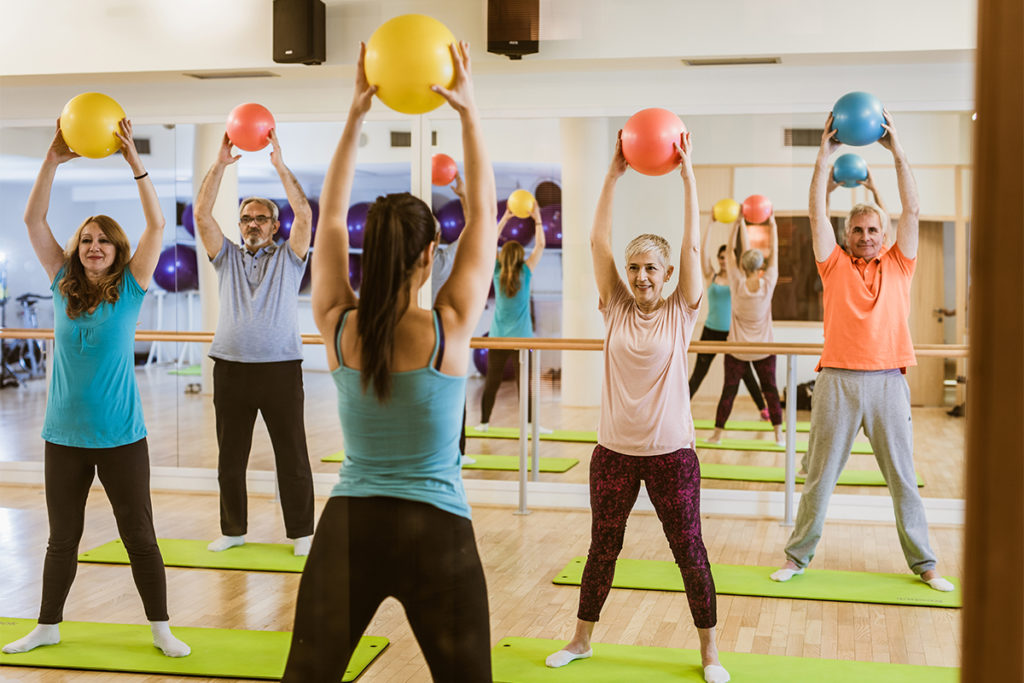Collective Corrections
Learn how to integrate corrective exercise into group fitness classes.

The 2008 IDEA Fitness Programs & Equipment Survey found that 85% of respondents serve members with chronic or temporary injuries. Given this information, it’s certainly possible that group fitness instructors are seeing more and more people in their classes who are exercising with some type of pain or imbalance. As an instructor, therefore, you may have opportunities to identify and correct musculoskeletal deviations in students (while staying within your scope of practice). Practicing this skill will keep you at the forefront of the developing corrective-exercise trend and help participants reach their health and fitness goals in a positive way.
This article explores three of the most common musculoskeletal imbalances, how to assess deviations during class, what exercises can make imbalances worse and, finally, how to correct them.
Three Common Issues
There are three common musculoskeletal imbalances you may see in your classes:
Overpronation. Pronation is a normal bodily function, in which the foot collapses inward toward the midline of the body. When people overpronate, the foot collapses too far inward. As the foot pronates, the leg also rotates inward toward the midline of the body, affecting knee and hip alignment. When the leg rotates inward, the pelvis usually moves into an anteriorly rotated position.
Anterior Pelvic Tilt. The pelvis is naturally rotated forward about 10 degrees in a standing position. However, if the front of the pelvis is too low in relation to the back of the pelvis, there is an excessive
anterior pelvic tilt. Look for an anterior rotation of more than 10 degrees. An anteriorly rotated pelvis usually accompanies excessive lumbar lordosis (overarching of the low back) and vice versa.
Excessive Thoracic Kyphosis. The thoracic spine is naturally rounded forward, forming a slight kyphotic curve. However, when this curvature is excessive and the shoulders round forward, it can become problematic. The overly rounded position causes the shoulder blades to move away from the spine and slide forward on the rib cage. This can affect correct functioning of the shoulder joints and arms. Excessive thoracic kyphosis usually accompanies excessive anterior pelvic tilt.
Assessing Overpronation During Class
Yoga. Yoga uses many standing poses. It is imperative that the feet and ankle complex is properly aligned in these poses. An easy way to help students become aware of the correct foot and ankle position is to teach them how to perform a simple hands-on assessment.
Instruct students, while standing, to bend forward to touch their toes and place the thumb of their left hand on the dimple on the inside of their left ankle (just forward of the ankle bone). Then ask them to place their forefinger on the dimple on the outside of the ankle bone. When both thumb and finger are in place, ask them to overpronate and flatten their feet. Coach them to feel the increase in pressure from the talus bone, which will have moved toward the thumb. Then ask them to oversupinate and shift their weight to the outside of the foot. They will now feel more talus bone pressure on the forefinger. Coach them to pronate and supinate until the pressure of the talus bone is even between the thumb and forefinger. Perform this technique on both ankles. Your students will now know how to get their feet and ankles into a neutral position for all standing poses.
Step/Cardio Class. The Achilles tendon attaches the calf muscles to the heel. When you look at the back of a person’s lower leg, you can determine whether he is overpronating by the alignment of his Achilles tendon. If he overpronates, the heel rolls inward toward the center of the body and the Achilles tendon appears to bow inward (see picture). When teaching, walk around and coach participants whose Achilles tendons are bowing in (overpronating) to raise their arches slightly to a more neutral position.
Exercise That Can Make Overpronation Worse
Yoga. The foot and ankle should and will pronate as your students transfer weight over the foot, as in a lunging warrior pose. However, many participants will not be used to exercising in bare feet and may overpronate because they lack the support of an arch-supported shoe. Therefore, poses that demand the body to over-reach or balance on one leg (e.g., balancing stick pose, or tuladandasana) should be added cautiously until the foot and ankle complex becomes stronger.
Step/Cardio Class. Transferring more force through the body in any given exercise will increase the likelihood that the foot and ankle will overpronate. This is why a step class with excessive amounts of stepping down can increase the likelihood of knee injuries. As the foot and ankle collapse, the knee will move toward the midline of the body, placing undue stress on the medial side of the knee. Over time this can lead to dysfunction, injury and pain.
How To Correct Overpronation
Yoga. Use the assessment technique detailed above to make students more aware of the neutral foot and ankle position when beginning each pose. As students shift their body weight forward and transfer weight onto the foot, coach them to push down with their big toe. This will act as a braking mechanism, giving the arch of the foot more stability and preventing the foot and ankle from collapsing incorrectly.
Step/Cardio Class. Use creative visualization techniques to help participants be more aware of their feet and avoid overpronation. Have them imagine there is a raw egg or baby chick under the arch of their feet when they are moving. This imagery will remind them to keep the arches up so as not to “crush” the egg or chick. It will also help strengthen their arches and prevent them from overpronating.
Assessing
Anterior Pelvic Tilt
Pilates. While your client is lying supine on the reformer with her legs straight and head down, slide your hand (palm down) under her low back (you should be able to get your fingers underneath). If you can slide your whole hand under, the low back is probably arching too much and she most likely has an anterior pelvic tilt. If the padding on the reformer is soft or your client has a large gluteus maximus, adjust your assessment accordingly.
Boot Camp. Instruct participants, while standing, to place their hands on the front of their pelvis, palms flat, with middle fingers touching. Most people will see only their first fingers when they look down at their hands. Teach your students to tilt the pelvis posteriorly, or under, until they see their middle fingers. They are now in or near a neutral pelvic position (see picture).
Exercises That Can Make Anterior Pelvic Tilt Worse
Pilates. The teaser is a great exercise for working the abdominals and hip flexor muscles. When performing the teaser, the hip/leg complex flexes and the torso and legs come together. This movement requires the pelvis to posteriorly rotate (tuck under) to ensure the hip flexes correctly. Since most people have an anterior pelvic tilt, the pelvis may not posteriorly rotate as it should. As a result, the abdominals and hip flexors will not work correctly, and undue stress will be placed on the low back.
Boot Camp. “Superman,” or prone cobra, puts the spine into excessive extension and can make an anterior pelvic tilt worse if done incorrectly. Many participants cannot extend or arch the thoracic spine upward when lying prone. Therefore, when they perform spinal extension lying face down, they are likely to hyperextend the lumbar spine and anteriorly rotate their pelvis to an excessive degree to achieve the desired movement. This can lead to compression of the lumbar disks.
How To Correct Anterior Pelvic Tilt
Pilates. Instead of having your client perform teasers with her torso off the pad, ask her to remain lying supine. Place your hand on the front of her pelvis to ensure that when she flexes the hip (lifts the leg), her pelvis does indeed posteriorly rotate. She should not have to make a conscious decision to posteriorly rotate the pelvis if the hip flexors are working correctly. Coach her to slightly rotate the leg out and perform one leg at a time until she can coordinate hip flexion correctly.
Although the pelvis will posteriorly rotate, the low back will not flatten completely. If the psoas major (the main hip flexor muscle) engages correctly, it will have a slight forward pull on the lumbar spine and will help keep it stable (the lumbar spine will be slightly arched).
Boot Camp. Performing prone spinal extension exercises with one modification can help ensure that participants do not hyperextend the lumbar spine or anteriorly rotate the pelvis. Coach clients to keep the bones at the front of the pelvis off the floor as they try to lift and extend the spine. They will need to engage the abdominal and gluteal muscles with a posterior pelvic tilt to ensure that the pelvis does not anteriorly rotate too much. As they increase their ability to extend in the thoracic spine, they will find that they can begin to focus less on stabilizing the pelvis and more on the action of extending the spine. This will help participants become more balanced and reduce their risk for a low-back injury.
Assessing Excessive Thoracic Kyphosis
Indoor Cycling. To assess thoracic kyphosis during class, you will need to get off your bike and walk around the room. Check spine, hips and head alignment when students are gripping the handlebars. The tragus of the ear, acromion of the shoulder and greater trochanter of the hip should all be in line (see picture).
Core Class. In a standing position, the place where the first rib meets the sternum should be parallel with the first thoracic vertebra. If the shoulders are rounded in an excessively kyphotic posture, the rib cage will drop. By drawing an imaginary line from the breastbone to the spine, you can evaluate whether students need to straighten the upper back, thereby raising the sternum and ribs (see picture).
Exercises That Can Make Thoracic Kyphosis Worse
Indoor Cycling. If participants keep their hands in contact with the handles for too long, they will eventually begin to slump forward. Consequently, when they look at you for cues, they will have to hyperextend the neck to bring their eyes up. Positions held too long while students have their hands on the handlebars will place undue stress on the upper back, neck and shoulders.
Core Class. If a participant has excessive thoracic kyphosis, the connective tissue at the front of the torso (anterior superficial fascia) may become restricted. Performing crunches on the ground can further irritate these tissues, which can lead to poor breathing patterns and a lack of blood supply to the organs.
How To Correct Thoracic Kyphosis
Indoor Cycling. Instruct participants to take their hands off the handles and sit upright. Ask them to raise both arms over their heads. Lifting the arms will require cyclists to extend the spine more, thereby strengthening the erector spinae muscles. To place more stress on the thoracic portion of the erector spinae, coach them not to arch the low back during this movement (see picture ). Also, ensure that participants sit upright with their hands off the handles as much as possible during the class. If a participant feels she might fall off the bike if both hands are off the handles, she can raise one arm at a time until she becomes more confident.
Core Class. Instruct class to perform crunches lying over a stability ball with their feet on a wall. Cue them to place both hands behind the head as they try to lower themselves back over the ball. Coach them to posteriorly tilt the pelvis so that arching over the ball happens predominantly in the upper back. This action of lowering over the ball will stretch out the soft-tissue structures of the abdominals and anterior fascia and help the upper back become more accustomed to extending.
More Fun for Everyone
If you can learn to assess participants, you will soon become familiar with their individual musculoskeletal imbalances. This will help you evaluate your program design and address pain while still creating a fun and energizing experience. n
Justin Price, MA
Justin Price, MA, is creator of the BioMechanics Method® Corrective Exercise Specialist (TBMM-CES) program, the fitness industry’s highest-rated CES credential, with trained professionals in 80 countries. He is also the author of several books, including The BioMechanics Method for Corrective Exercise academic textbook, and he was awarded the 2006 IDEA Personal Trainer of the Year. He has served as a subject matter expert for numerous brands and media organizations including ACE, TRX® and BOSU®; the BBC, Discovery Health and MSNBC; Arthritis Today, Men’s Health, Newsweek, Time, WebMD and Tennis; and Los Angeles Times, The New York Times and Wall Street Journal. Learn more about The BioMechanics Method®




